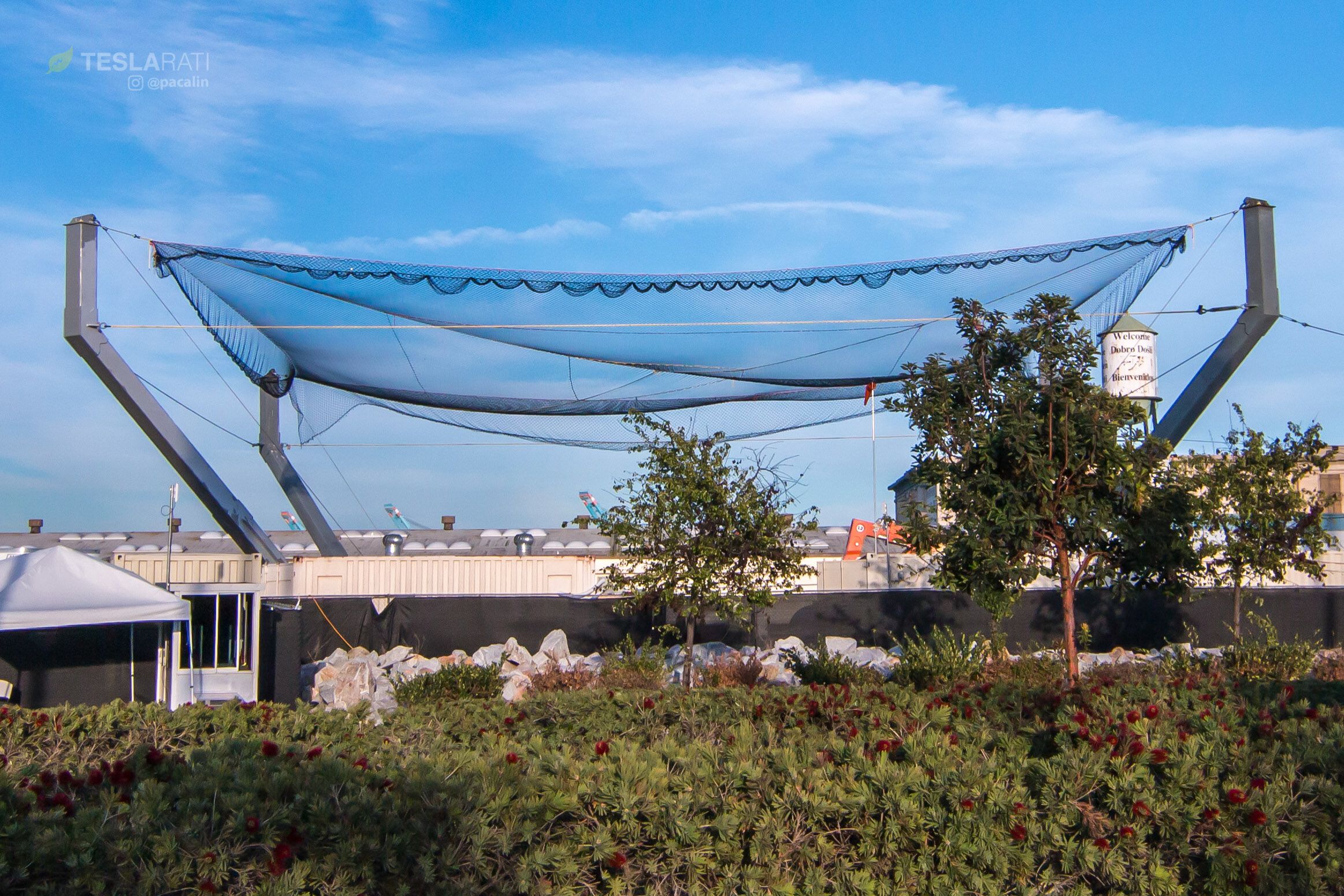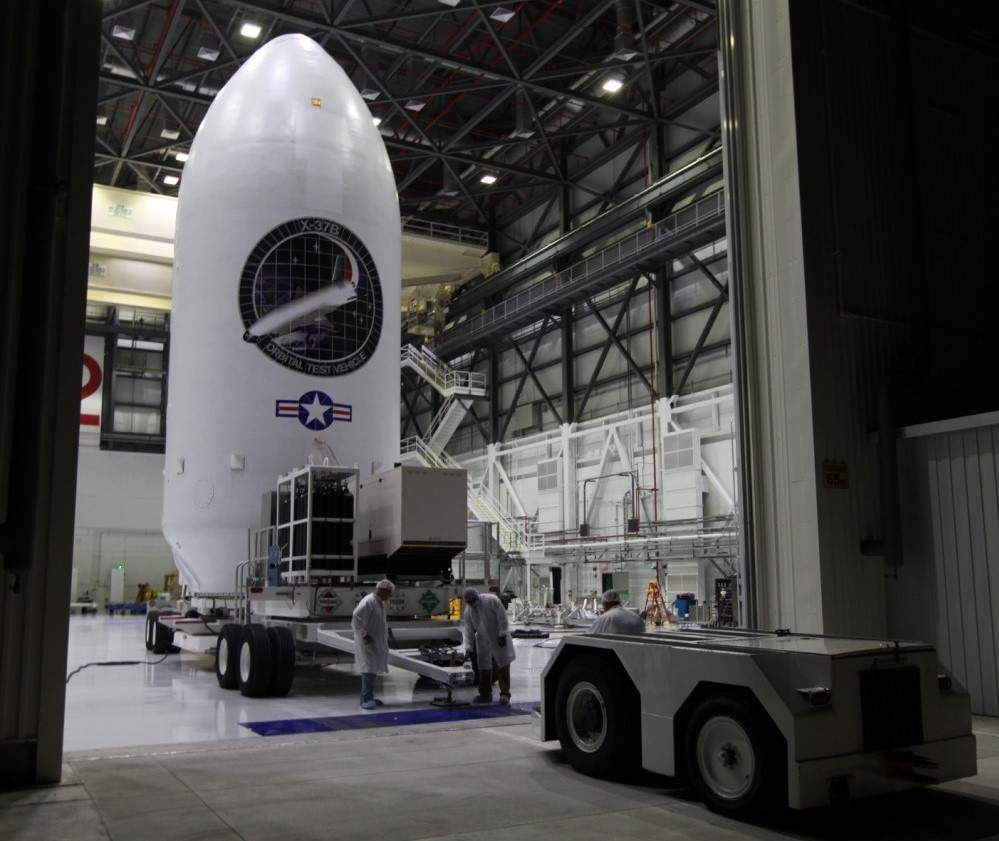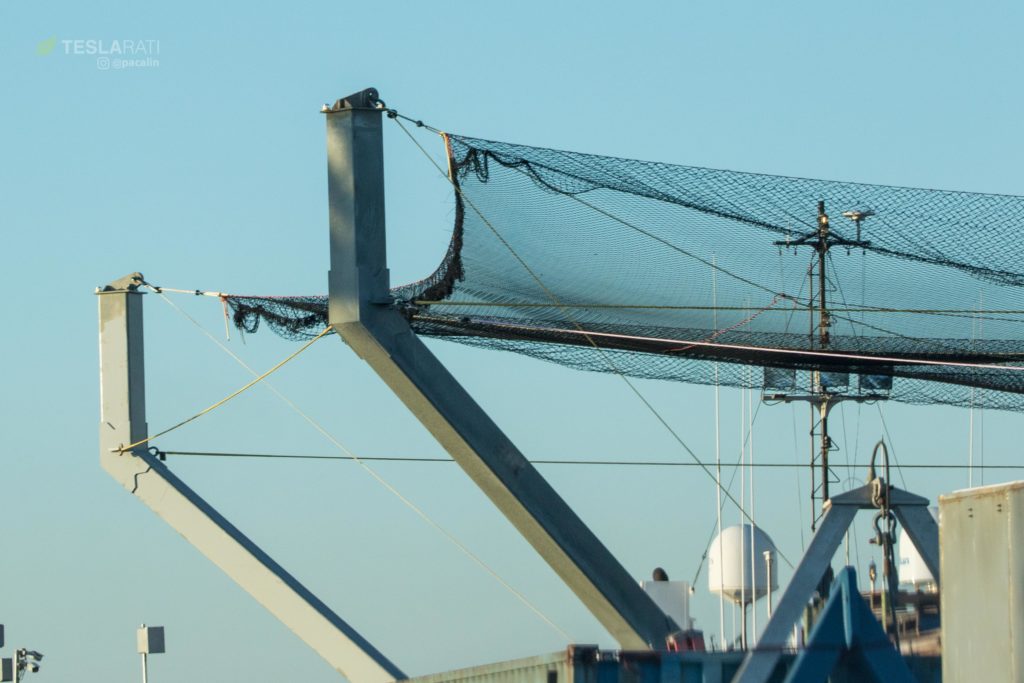

News
SpaceX’s claw-boat ready to recover rocket fairing with a giant net
Teslarati’s West coast photographer Pauline Acalin has captured some amazing photos of one of SpaceX’s most immediately recognizable fairing recovery vessels berthed in the Port of San Pedro. For the first time ever, the vessel (officially named Mr. Steven) has had its iconic claw rigged with a massive net intended to gently capture Falcon 9 payload fairings.
SpaceX has been trying in earnest to recover its rockets’ fairings for approximately one year, but has yet to recover a fairing intact. While the company appeared to have recovered at least one large fragment on the East coast, success has proven elusive, and CEO Elon Musk noted in press conferences before and after Falcon Heavy’s inaugural launch that the task had proven more difficult than was anticipated. Despite the difficulties, SpaceX has no intention of surrendering their valuable fairings (a $5 million pallet of cash, as Musk once joked) to the sea.
- Imagine this building-sized fairing traveling approximately TWO MILES PER SECOND. (USAF)
- Mr Steven’s big ‘ole net and iconic claws hunger for Falcon fairings. (Pauline Acalin/Teslarati)
Along with the imminent introduction of SpaceX’s upgraded “Fairing 2.0” on the upcoming Wednesday launch of PAZ, chances of a successful fairing recovery are almost certainly higher than ever before. While SpaceX and CEO Musk has only revealed that the upgraded fairing is somewhat larger than its predecessor, it can also be more or less guaranteed that its aforementioned upgrades go well beyond larger dimensions, likely extending into improved reusability hardware, greater ease of manufacture, and much more. This should come as no surprise – SpaceX has a long and storied history of making constant, iterative improvements to all aspects of itself, be it hardware, software, design, or manufacturing.

Mr. Steven’s fancy new net captured in the golden hour before sunset at L.A.’s Port of San Pedro. (Pauline Acalin/Teslarati)
Enter Mr. Steven’s fancy new netting. While no bouncy castle, a highly maneuverable vessel with an effortlessly reusable net is arguably far superior to a dead-in-the-water piece of inflatable plastic. As the fairing (theoretically) floats gently down to the surface of the ocean under its guided parachute, Mr. Steven’s coxswain will be tasked with skillfully maneuvering the boat to account for any the sea state and any winds in order to maintain its position at the fairing’s destination. If all goes well, at least half of Falcon 9’s payload fairing will gently drop into Mr. Steven’s net, marking SpaceX’s first successful recovery. If things don’t go exactly as planned, a 1000kg hunk of metal and composite could theoretically smash into poor Mr. Steven at an unhealthy velocity. However, things are looking considerably more positive this time around.
SpaceX’s fairing grabber, Mr. Steven, a couple days ago preparing to ship out for Wednesday’s launch at Vandenberg. @Teslarati #paz #Starlink pic.twitter.com/lfWjUGy56k
— Pauline Acalin (@w00ki33) February 19, 2018
By all appearances, SpaceX has retained the same general strategy of fairing recovery mentioned in the past by Musk and other executives. To oversimplify, after launch, the payload fairing separates (mechanically) from the second stage once Falcon 9 or Heavy has left behind the majority of Earth’s atmosphere. After separation, each fairing half orients itself for a gentler reentry into the atmosphere with cold nitrogen gas thrusters, likely the exact same thrusters used in part to achieve Falcon 9’s accurate and reliable landings. Due to their massive surface area and comparatively tiny weight, fairing halves effectively become exceptionally finicky and awkward sails falling through the atmosphere at insane velocities, with the goal generally being to orient each half like a boat’s hull to provide some stability. Once they are low enough, assuming they’ve survived the journey from TEN TIMES THE SPEED OF SOUND and 62 MILES above Earth’s surface to a more reasonable ~Mach 0.5 and maybe 5 miles of altitude, the fun parts begin. At this point, each fairing half deploys a GPS-connected parachute system (a parasail, to be exact) capable of directing the massive hunks of carbon fiber and aluminum to a very specific point on the surface of the ocean.
Successful fairing recovery would quite literally entail an immediate cost reduction of as much as 10% of a Falcon 9’s entire advertised launch price, ~$6 million. For recovery of a single half, that figure is of course…halved, but $3 million is still an impressive instantaneous cost reduction. It’s unclear how SpaceX eventually intends to recover both halves of the fairing – a Mr. Steven sibling, perhaps? – but that is a problem for future SpaceX!
Mr. Steven and his net are likely to get their first taste of action in just two days – PAZ and two of SpaceX’s very own prototype internet satellites are set to launch at 6:17 am PST on Wednesday, February 21. Stay tuned for a link to SpaceX’s official webcast and follow us on social media for down-to-the-minute updates.
Teslarati – Instagram – Twitter
Tom Cross – Twitter
Pauline Acalin – Twitter
Eric Ralph – Twitter
https://twitter.com/_TomCross_/status/965394574578540545
News
Tesla begins Robotaxi certification push in Arizona: report
Tesla seems serious about expanding its Robotaxi service to several states in the coming months.

Tesla has initiated discussions with Arizona transportation regulators to certify its driverless Robotaxi service in the state, as per a recent report from Bloomberg News. The move follows Tesla’s launch of its Robotaxi pilot program in Austin, Texas, as well as CEO Elon Musk’s recent comments about the service’s expansion in the Bay Area.
The Arizona Department of Transportation confirmed to Bloomberg that Tesla has reached out to begin the certification process for autonomous ride-sharing operations in the state. While details remain limited, the outreach suggests that Tesla is serious about expanding its driverless Robotaxi service to several territories in the coming months.
The Arizona development comes as Tesla prepares to expand its service area in Austin this weekend, as per CEO Elon Musk in a post on X. Musk also stated that Tesla is targeting the San Francisco Bay Area as its next major market, with a potential launch “in a month or two,” pending regulatory approvals.
Tesla first launched its autonomous ride-hailing program on June 22 in Austin with a small fleet of Model Y vehicles, accompanied by a Tesla employee in the passenger seat to monitor safety. While still classified as a test, Musk has said the program will expand to about 1,000 vehicles in the coming months. Tesla will later upgrade its Robotaxi fleet with the Cyercab, a two-seater that is designed without a steering wheel.
Sightings of Cybercab castings around the Giga Texas complex suggests that Tesla may be ramping the initial trial production of the self-driving two-seater. Tesla, for its part, has noted in the past that volume production of the Cybercab is expected to start sometime next year.
In California, Tesla has already applied for a transportation charter-party carrier permit from the state’s Public Utilities Commission. The company is reportedly taking a phased approach to operating in California, with the Robotaxi service starting with pre-arranged rides for employees in vehicles with safety drivers.
News
Tesla sets November 6 date for 2025 Annual Shareholder Meeting
The automaker announced the date on Thursday in a Form 8-K.

Tesla has scheduled its 2025 annual shareholder meeting for November 6, addressing investor concerns that the company was nearing a legal deadline to hold the event.
The automaker announced the date on Thursday in a Form 8-K submitted to the United States Securities and Exchange Commission (SEC). The company also listed a new proposal submission deadline of July 31 for items to be included in the proxy statement.
Tesla’s announcement followed calls from a group of 27 shareholders, including the leaders of large public pension funds, which urged Tesla’s board to formally set the meeting date, as noted in a report from The Wall Street Journal.
The group noted that under Texas law, where Tesla is now incorporated, companies must hold annual meetings within 13 months of the last one if requested by shareholders. Tesla’s previous annual shareholder meeting was held on June 13, 2024, which placed the July 13 deadline in focus.
Tesla originally stated in its 2024 annual report that it would file its proxy statement by the end of April. However, an amended filing on April 30 indicated that the Board of Directors had not yet finalized a meeting date, at least at the time.
The April filing also confirmed that Tesla’s board had formed a special committee to evaluate certain matters related to CEO Elon Musk’s compensation plan. Musk’s CEO performance award remains at the center of a lengthy legal dispute in Delaware, Tesla’s former state of incorporation.
Due to the aftermath of Musk’s legal dispute about his compensation plan in Delaware, he has not been paid for his work at Tesla for several years. Musk, for his part, has noted that he is more concerned about his voting stake in Tesla than his actual salary.
At last year’s annual meeting, TSLA shareholders voted to reapprove Elon Musk’s compensation plan and ratified Tesla’s decision to relocate its legal domicile from Delaware to Texas.
Elon Musk
Grok coming to Tesla vehicles next week “at the latest:” Elon Musk
Grok’s rollout to Tesla vehicles is expected to begin next week at the latest.

Elon Musk announced on Thursday that Grok, the large language model developed by his startup xAI, will soon be available in Tesla vehicles. Grok’s rollout to Tesla vehicles is expected to begin next week at the latest, further deepening the ties between the two Elon Musk-led companies.
Tesla–xAI synergy
Musk confirmed the news on X shortly after livestreaming the release of Grok 4, xAI’s latest large language model. “Grok is coming to Tesla vehicles very soon. Next week at the latest,” Musk wrote in a post on social media platform X.
During the livestream, Musk and several members of the xAI team highlighted several upgrades to Grok 4’s voice capabilities and performance metrics, positioning the LLM as competitive with top-tier models from OpenAI and Google.
The in-vehicle integration of Grok marks a new chapter in Tesla’s AI development. While Tesla has long relied on in-house systems for autonomous driving and energy optimization, Grok’s integration would introduce conversational AI directly into its vehicles’ user experience. This integration could potentially improve customer interaction inside Tesla vehicles.
xAI and Tesla’s collaborative footprint
Grok’s upcoming rollout to Tesla vehicles adds to a growing business relationship between Tesla and xAI. Earlier this year, Tesla disclosed that it generated $198.3 million in revenue from commercial, consulting, and support agreements with xAI, as noted in a report from Bloomberg News. A large portion of that amount, however, came from the sale of Megapack energy storage systems to the artificial intelligence startup.
In July 2023, Musk polled X users about whether Tesla should invest $5 billion in xAI. While no formal investment has been made so far, 68% of poll participants voted yes, and Musk has since stated that the idea would be discussed with Tesla’s board.
-

 Elon Musk1 week ago
Elon Musk1 week agoTesla investors will be shocked by Jim Cramer’s latest assessment
-

 Elon Musk3 days ago
Elon Musk3 days agoElon Musk confirms Grok 4 launch on July 9 with livestream event
-

 Elon Musk13 hours ago
Elon Musk13 hours agoxAI launches Grok 4 with new $300/month SuperGrok Heavy subscription
-

 News7 days ago
News7 days agoTesla Model 3 ranks as the safest new car in Europe for 2025, per Euro NCAP tests
-

 Elon Musk2 weeks ago
Elon Musk2 weeks agoA Tesla just delivered itself to a customer autonomously, Elon Musk confirms
-

 Elon Musk1 week ago
Elon Musk1 week agoxAI’s Memphis data center receives air permit despite community criticism
-

 Elon Musk2 weeks ago
Elon Musk2 weeks agoTesla’s Omead Afshar, known as Elon Musk’s right-hand man, leaves company: reports
-

 News2 weeks ago
News2 weeks agoXiaomi CEO congratulates Tesla on first FSD delivery: “We have to continue learning!”















